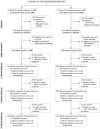A Cluster-Randomized Study of Technology-Assisted Health Coaching for Weight Management in Primary Care
- PMID: 39313341
- PMCID: PMC11419716
- DOI: 10.1370/afm.3150
A Cluster-Randomized Study of Technology-Assisted Health Coaching for Weight Management in Primary Care
Abstract
Purpose: We undertook a trial to test the efficacy of a technology-assisted health coaching intervention for weight management, called Goals for Eating and Moving (GEM), within primary care.
Methods: This cluster-randomized controlled trial enrolled 19 primary care teams with 63 clinicians; 9 teams were randomized to GEM and 10 to enhanced usual care (EUC). The GEM intervention included 1 in-person and up to 12 telephone-delivered coaching sessions. Coaches supported goal setting and engagement with weight management programs, facilitated by a software tool. Patients in the EUC arm received educational handouts. We enrolled patients who spoke English or Spanish, were aged 18 to 69 years, and either were overweight (body mass index 25-29 kg/m2) with a weight-related comorbidity or had obesity (body mass index ≥30 kg/m2). The primary outcome (weight change at 12 months) and exploratory outcomes (eg, program attendance, diet, physical activity) were analyzed according to intention to treat.
Results: We enrolled 489 patients (220 in the GEM arm, 269 in the EUC arm). Their mean (SD) age was 49.8 (12.1) years; 44% were male, 41% Hispanic, and 44% non-Hispanic Black. At 12 months, the mean adjusted weight change (standard error) was -1.4 (0.8) kg in the GEM arm vs -0.8 (1.6) kg in the EUC arm, a nonsignificant difference (P = .48). There were no statistically significant differences in secondary outcomes. Exploratory analyses showed that the GEM arm had a greater change than the EUC arm in mean number of weekly minutes of moderate to vigorous physical activity other than walking, a finding that may warrant further exploration.
Conclusions: The GEM intervention did not achieve clinically important weight loss in primary care. Although this was a negative study possibly affected by health system resource limitations and disruptions, its findings can guide the development of similar interventions. Future studies could explore the efficacy of higher-intensity interventions and interventions that include medication and bariatric surgery options, in addition to lifestyle modification.
Keywords: barriers; comorbidity; diet; ethnic and racial minorities; goal setting; health coaching; health informatics; lifestyle; motivation; obesity; overweight; physical activity; practice-based research; primary care; self-management; veterans; vulnerable populations; weight loss.
© 2024 Annals of Family Medicine, Inc.
Figures
Similar articles
-
Mobile health (m-health) smartphone interventions for adolescents and adults with overweight or obesity.Cochrane Database Syst Rev. 2024 Feb 20;2(2):CD013591. doi: 10.1002/14651858.CD013591.pub2. Cochrane Database Syst Rev. 2024. PMID: 38375882 Free PMC article.
-
An Adaptive Behavioral Intervention for Weight Loss Management: A Randomized Clinical Trial.JAMA. 2024 Jul 2;332(1):21-30. doi: 10.1001/jama.2024.0821. JAMA. 2024. PMID: 38744428 Free PMC article. Clinical Trial.
-
Interventions to change the behaviour of health professionals and the organisation of care to promote weight reduction in children and adults with overweight or obesity.Cochrane Database Syst Rev. 2017 Nov 30;11(11):CD000984. doi: 10.1002/14651858.CD000984.pub3. Cochrane Database Syst Rev. 2017. PMID: 29190418 Free PMC article.
-
Diet, physical activity and behavioural interventions for the treatment of overweight or obese children from the age of 6 to 11 years.Cochrane Database Syst Rev. 2017 Jun 22;6(6):CD012651. doi: 10.1002/14651858.CD012651. Cochrane Database Syst Rev. 2017. PMID: 28639319 Free PMC article.
-
Weight loss interventions for chronic asthma.Cochrane Database Syst Rev. 2012 Jul 11;2012(7):CD009339. doi: 10.1002/14651858.CD009339.pub2. Cochrane Database Syst Rev. 2012. PMID: 22786526 Free PMC article.
Cited by
-
Lifestyle Medicine for Obesity in the Era of Highly Effective Anti-Obesity Treatment.Nutrients. 2025 Jul 21;17(14):2382. doi: 10.3390/nu17142382. Nutrients. 2025. PMID: 40733007 Free PMC article. Review.
References
-
- Hales CM, Carroll MD, Fryar CD, Ogden CL.. Prevalence of obesity and severe obesity among adults: United States, 2017–2018. NCHS Data Brief. 2020; (360): 1-8. Accessed May 23, 2024. https://www.cdc.gov/nchs/data/databriefs/db360-h.pdf - PubMed
Publication types
MeSH terms
Grants and funding
LinkOut - more resources
Full Text Sources
Medical
Research Materials

